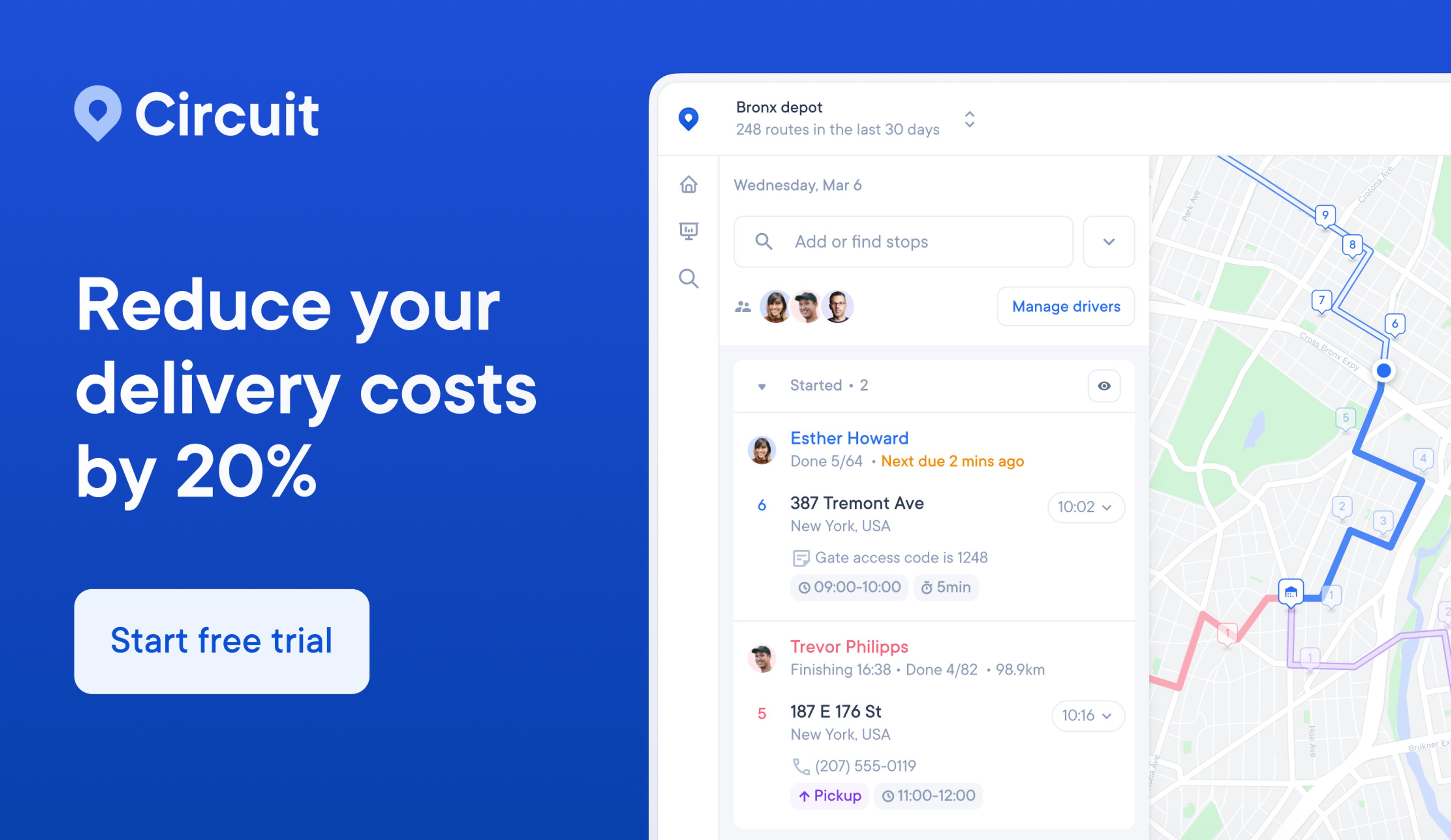ECommerce Distribution: Everything You Need to Know

Trust Circuit for Teams to help you optimize one of the most important (and expensive!) steps of the eCommerce distribution process — last-mile delivery.
Anyone who thinks eCommerce is an easy way to make a few extra bucks clearly hasn’t done it.
If you sell products online, you know better.
From managing your eCommerce website to processing payments and handling customer support, a lot goes into running an online shop.
Distribution is one of the most important parts of running an eCommerce store.
ECommerce distribution is an umbrella term that refers to the various steps online retailers take to move products from distribution centers to customers.
While that might sound straightforward enough, it’s actually pretty complicated.
The process involves a lot of steps, and you want to make sure you complete each step accurately and efficiently to meet customer expectations.
Otherwise, you run the risk of a customer not getting their goods on time — or at all.
So, what does it take to optimize your eCommerce distribution process?
I’ll cover the basic steps and explain how to streamline them below.
I’ll also talk about some challenges you may face when optimizing distribution channels for your eCommerce platform.
Key takeaways
- eCommerce distribution refers to the process of getting physical products sold on online marketplaces to the customers who purchase them and involves multiple steps from processing a customer’s order to the returns process.
- Optimizing the steps involved in eCommerce distribution can help create a positive customer experience, increase repeat orders, and reduce operating costs for businesses.
- The four main steps of eCommerce distribution include order management, shipping, last-mile delivery, and returns, and common challenges to eCommerce fulfillment and distribution include inventory management issues and long go-to-market time.

What is eCommerce distribution?
ECommerce distribution refers to the process of getting physical products sold on online marketplaces to the customers who purchase them.
The distribution process involves multiple steps, from processing a customer’s order at a warehouse to sending it out for last-mile delivery to putting that order in the customer’s hands.
The returns process — when a customer sends an item back — is also part of the eCommerce distribution process.
Online stores and eCommerce retailers use various strategies to optimize the distribution process, making it faster and cheaper and reducing overall operating costs.
I’ll talk about some of those strategies below.
How does eCommerce distribution work?
When an eCommerce company gets a customer order, a lot goes on behind the scenes to fulfill that order.
As a retailer, the order fulfillment process involves:
- Making sure you have the inventory on hand to supply the customer’s order
- Picking the order from your warehouse or storage facility
- Packaging the order for the customer
- Sending out the order, making sure it goes to the right person and place
- Confirming the order arrived safely
Optimizing these steps can help you create a positive customer experience.
For example, accurate order management helps make sure the right type of product gets to the right customer.
Happy customers = repeat orders = more business.
Effective distribution strategies also benefit businesses.
For example, optimizing steps like last-mile delivery can save time and money.
Planning fuel-efficient routes for your drivers saves on gas, for instance.
Below, I get into more detail about the core steps of the distribution process — and give you some tips on optimizing eCommerce distribution.

ECommerce distribution in 4 steps
ECommerce distribution typically involves four main steps. Here’s what distribution businesses need to do.
1. Order management
A customer placed an order in your store. Congratulations: You’ve made an online sale!
Order management starts when the customer places their order. What’s next?
First, you have to approve their order. For example, make sure you have the inventory the customer has requested. (Discover seven tips for tracking inventory.)
Next, you have to authorize their payment.
Finally, you have to send the order for picking and packing, which might mean notifying your in-house warehouse team or external dropshipping partner.
The warehouse team fulfills the order, finding it on the shelves, packaging it, and preparing it for shipping.
(Learn about the most efficient warehouse layouts to help your in-house team with picking.)
Now, while you do all that, you don’t want to leave your customer hanging.
Ideally, you’ll send a confirmation email confirming their purchase details. Include a receipt and customer service contact info.
Check out our post on improving your customer order management.
2. Shipping
Shipping seems easy enough: Just toss the package onto the delivery truck, right? If only it were that easy.
The package doesn’t go directly to the customer after it’s left the fulfillment center (like your warehouse).
Most eCommerce retailers have multiple smaller fulfillment centers that dispatch packages to larger, more centrally located shipping centers first.
The packages then go from the shipping centers to regional hubs.
Then, from these regional hubs, packages are out for local distribution — this brings us to the next step: last-mile delivery.
3. Last-mile delivery
Last-mile delivery is the final step in the package’s long journey from retailer to consumer.
It’s when the goods actually arrive at the customer’s door (yay!).
Although it’s often the shortest step in the process, last-mile delivery is often the most expensive step in the supply chain process. In fact, it makes up 53 percent of shipping costs!
This is because you aren’t just sending one bulk order to one spot — like from your warehouse to a shipping center.
You’re sending many individual packages to many individual locations, meaning greater demands on human power, vehicles, fuel usage, and more.
4. Returns
Real talk: Returns are sort of a nightmare for eCommerce retailers.
But they’re an unavoidable part of the process.
An efficient returns process can make life easier for your business and your customers. Streamlined returns can also help cut costs and simplify operations.
Basically, you’ve got all the above steps to cover, but in reverse.
You need to pick up the order from the customer’s house (or have them drop it at a post office or similar), get it to a shipping center, and send it to your distribution facility (like a warehouse).
You also have to process the return, which means refunding the customer’s payment, confirming the return, and processing the physical item.
For example, you might have to quality control check the item to decide whether it can be repackaged and resold.
Don’t despair: We can help you deal with returns! Read our post on returns management 101.

What are the key challenges of eCommerce distribution?
The eCommerce distribution process involves a lot of steps.
It’s no surprise that you can expect some hurdles along the way.
Common challenges to eCommerce fulfillment and distribution include:
- Inventory management issues. From not being able to find goods in a warehouse to not having them in stock, inventory management problems can hold up the entire distribution process. The larger your eCommerce business and the more inventory you have to track, the tougher it gets.
- Long go-to-market time (GTM). GTM time is an issue that can impact new inventory. If you add new inventory, you need to get it in stock, add listings to your website, and promote it. Minimizing your GTM (how long it takes to put a new product out there) is important.
- Sales channel management glitches. Your eCommerce sales channel should be user-friendly, bug-free, and streamlined. Customers who have issues like delayed payment approval may get frustrated and walk away.
- Listing discrepancies. You risk disappointing customers when you don’t advertise your products properly. This is especially tricky if you list products on multiple online platforms, like Shopify, Amazon, and eBay. You need to describe products similarly across all the platforms.
- Promotional issues. Make sure promotional specials like coupon codes or email discounts work. Otherwise, your order processing can get stuck.
- Lack of data. Which products are selling well? Which are flopping? How long does it take to get a product from point A to point B? Collecting data about your sales and distribution processes is the first step to improving them.
ECommerce distribution improvement strategies
Now that you know what challenges you might face in eCommerce distribution, the question is how can you improve it?
Try these hacks:
- Pick the right warehousing management system. The right management starts with the right kind of warehouse. This can impact things like how fast your team picks, packs, and processes inventory. Even the shape of the warehouse (like U- versus L-shape) makes a difference. I talk more about warehouse management in this comprehensive guide.
- Automate what you can. Automation can take the headache out of tasks like planning driver routes. You can also automate tasks like inventory management and employee scheduling (check out my article on the best employee scheduling tools).
- Negotiate better shipping rates. If you’ve scaled up your business since you started, you might be able to renegotiate shipping rates and get a better price. Services may offer discounts if you meet a certain amount of shipments per month, for example.
- Increase your distribution center’s capacity. There are many ways to up your capacity, for example, by using third-party logistic services. You can also boost efficiency by optimizing processes like route planning. You know what I’m about to say: Circuit for Teams can help!
- Go digital and cut the paperwork. Paperwork creates too much admin burden. Embrace digital options, which are easier to save and share. For example, use Circuit for Teams to take a photo of delivered items instead of getting physical signatures for proof of delivery. You can even share the POD directly with the customer.
- Use real-time tracking for your drivers. Circuit for Teams uses GPS so you can track drivers in real time and communicate with them live (through the driver app).
Optimize your delivery team with help from Circuit for Teams
Circuit for Teams can simplify one of the trickiest and most costly parts of the eCommerce distribution process: last-mile delivery.
With Circuit for Teams, you can quickly optimize routes and assign them to drivers.
Circuit for Teams offers route optimization, real-time driver tracking, and automated customer notifications.
We’re always updating our product based on customers’ needs, which is why we recently added fixed versus flexible delivery time windows, dynamic stop status icons, and more API integrations.
Ready to try it for yourself? Get Circuit for Teams now.


